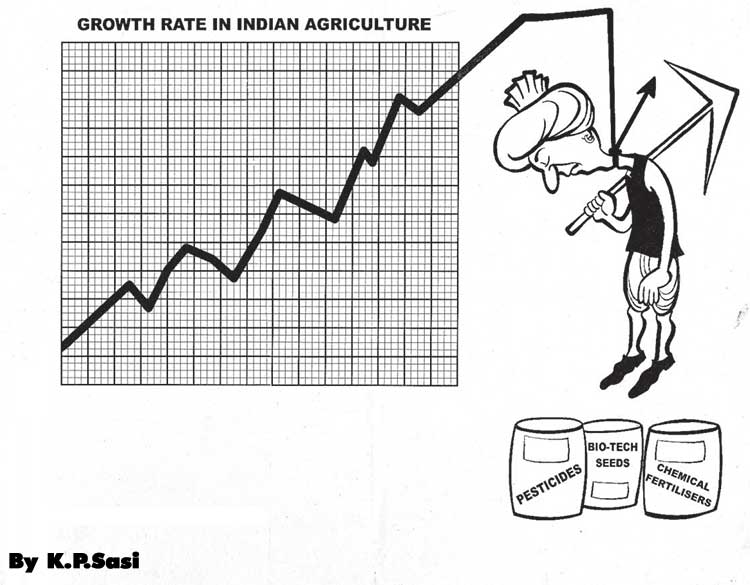
Even as India celebrated its 70th year of independence, the number of suicides of beleaguered farmers in Marathwada, the drought prone belt of Maharashtra, touched a new high. In the last seven and half months ending with !5th August ,580 cultivators have committed suicide .At the end of July, the toll stood at 531 and it has gone up to 580 in just 15 days.
The total suicidal deaths in Marathwada in the entire 2016 were 542, and the figure for 2015 was 354. Thus in seven and half months this year the number of suicides has gone up by 38 in comparison to the figure for the entire last year .The tragedy is all the more serious since 2016-2017 had good rainfall and better agricultural prices to support a successful harvest .This is certainly symptomatic of a deep malaise .
Many farmers drink toxic pesticides as a way out of backbreaking debt, with the government in some cases guaranteeing monetary aid to their surviving families. That provides a perverse incentive for suicide, rewarding people who end their lives by paying family compensation, but only if they die.
In Maharashtra, probably the richest state in India In the past decade, thousands of farmers in India — mostly in Andhra Pradesh, Maharashtra and Gujarat — have hung themselves or taken pesticide. Over the past few years, Maharashtra has topped the list of “suicide states”.
A 21-year-old student, the daughter of a Maharashtra farmer, Sheetal Yankat decided to end her life by jumping into a village well. In her suicide note, she wrote: “My parents are extremely poor and have been unable to raise money for my marriage. I am committing suicide because I don’t want my parents to come under a debt burden. The economic condition of my family has worsened over the last five years because of the failure of crops. My two sisters got married somehow, with very simple marriage ceremonies. My father is trying his best for my marriage. But since the middlemen are not able to lend money, my marriage got delayed for two years. Therefore, I am ending my life with the hope that my father will not be burdened by any more debt and perhaps my death will also end the dowry practice.”
Several studies have shown that almost 58 to 62 percent farmers sleep on empty stomachs. . While the policy emphasis has been on increasing crop production, the more important issue of whether this is accompanied by a rise in farm incomes has been simply pushed under the carpet.
The reasons for the gloom on the farm are all there for everybody to see.
The University of California, Berkeley suggests India will see more such tragedies as climate change brings hotter temperatures that damage crops and exacerbate drought. For every 1 degree Celsius (1.8 degrees Fahrenheit) of warming above 20 degrees C (68 degrees F) during the growing season in India, there are 67 more suicides on average, according to the findings published in the Proceedings of the National Academy of Sciences, or PNAS. An increase of 5 Celcius on any one day was associated with an additional 335 deaths. In total, it estimates that 59,300 agricultural sector suicides over the past 30 years could be attributed to warming.
The message “is that farming is an inherently risky occupation, with annual incomes often held hostage to the weather, and it’s getting riskier in the era of climate change,” according to Vikram Patel, an Indian psychiatrist and mental health expert with Harvard Medical School in Boston
Experts said the study’s findings should raise alarms, especially with India’s average temperatures expected to rise another 3 degrees C (5.4 degrees F) by 2050. That will bring more erratic weather events, more drought and stronger storms.
Farming has always been considered a high-risk profession, and a single damaged harvest can drive some to desperation. With agriculture supporting more than half of India’s 1.3 billion people, farmers have long been seen as the heart and soul of the country. But they’ve also seen their economic clout diminish over the last three decades. Once accounting for a third of India’s gross domestic product, they now contribute only 15 percent of India’s $2.26 billion economy.
Former RBI Governor Raghuram Rajan used to say that the biggest reforms would be when farmers are moved out of agriculture, to meet the ever-growing demand for cheaper labour for the infrastructure industry.
We believe in “uttam kheti, madhyam vyapar and neech naukri”. India’s first Prime Minister Jawaharlal Nehru said in 1947, “Everything can wait, but not agriculture.” What India is witnessing today is exactly the reverse. All the other sectors in the Indian economy are surging ahead. Agriculture is the only one which is moving in the opposite direction. Within this self-perpetuating cycle of misery, wrapping a noose around the neck are all-too-friendly exits for farmers. While their deaths might bring personal escape, they leave behind crippling emotional, financial and physical burdens, inherited by those left to farm the dust: women who live to re buld ther ilivs and that of their families on the debris left by their broken hearted husbands.
Moin Qazi is the author of the bestselling book, Village Diary of a Heretic Banker .He has worked in the development finance sector for almost four decades .He can be reached at [email protected]










































